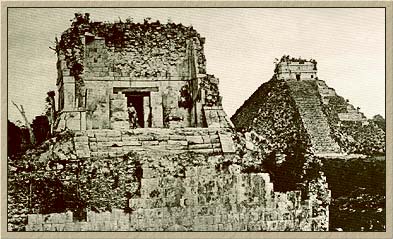  
The first mention of the name Chichen Itza comes from Fray Diego de Landa, writing about the history of Yucatan some time in the last half of the sixteenth century. It seems that Chichen Itza was a site strongly linked with Pre-Hispanic history and myth, as repeated mentions of its name can be found in the 1579 Relaciones Geográficas, as well as in other documents of that time. At one point, Francisco de Montejo, the official conqueror of Yucatan, tried to establish himself at or near Chichen, but the hostility of local Maya groups succeeded in driving him away. The site's name resurfaces periodically in documents through most of the Colonial period, but no real interest in exploring it ever materialized until the 1840s, when the famous explorers John Lloyd Stephens and Frederick Catherwood brought the attention of the world to it through the report of their two weeks of work there in 1842. Stephens' elegant prose and Catherwood's magnificent drawings of several of Chichen's buildings were supplemented by a map of the site. Despite the very real dangers created by the Caste War (1846-1900), the French adventurer/photographer Desiré Charnay managed to reach the site, protected by a military escort, proceeding to document several of the most important vestiges that were visible at the time. Between 1875 and 1883, another Frenchman, Augustus LePlongeon, carried out the first excavations at the site, although his tendency towards extravagance and self-aggrandizement robbed his work of serious consideration. He is credited with coming up with the name chac mool, which to this day is applied to certain reclining anthropomorphic sculptures, although there is no base anywhere in the source documentation to support the authenticity of this name. Between the 1880s and the 1890s, two excellent photographer/explorers, Teobert Maler and Alfred P. Maudslay, worked at the site independently of each other. The works they published would make available to the public, for the first time, a detailed record of the site, its architecture and sculpture. William Holmes carried out important studies of the ancient city's architecture in 1895, while Adela Breton, between 1900 and 1907, made color copies of the city's mural paintings, most of which are today completely lost. The German scholar Eduard Seler, who was unquestionably the foremost authority of his time on codices and source documents, visited the site several times, bringing important insights to its understanding. At around the turn of the nineteenth century, the American Edward Thompson bought the nearby hacienda and eventually turned his attention to trying to salvage any artifacts that might still be lying at the bottom of the site's famous Sacred Cenote (a cenote is a natural well or sinkhole that is very common in certain areas of the Yucatan peninsula). To achieve his purpose, he obtained a dredge and enlisted the help of professional divers. He was able to recover many artifacts, most of which were illegally sent ouf of the country to Harvard's Peabody Museum. Between 1923 and 1935, Sylvanus Morley and Alfred Kidder directed the Carnegie Institution's archaeological investigations at the site. Not only was their project to produce a comprehensive map of the site core and its southern portion, but it was also responsible for consolidating and rebuilding structures such as the Temple of the Warriors and the Caracol, among others. Simultaneously to the Carnegie project, a Mexican project, under the direction of José Erosa and Miguel Angel Fernández, worked on structures such as the Castillo, the Great Ballcourt and the platforms of the North Plaza, to name but the most important. In the postwar years, well-known archaeologists, such as Alberto Ruz, Jorge Acosta and Román Piña Chan worked at the site, although their work was mostly consolidation and maintenance. In the 1960s, the Sacred Cenote became again the focus of attention. Extensive work there, unfortunately, yielded less than previously hoped and the project was eventually discontinued. More recently, in the late 1970s, the southern and eastern façades of the Castillo were consolidated, while the 1990-1991 season saw most of the Western Colonnade restored, as well as a large portion of the area known as the Thousand Columns and the Market. The latest senior excavator at the site is Dr. Peter Schmidt, who not only directed the Chichen Itza Special Project in the years between 1992 and 1994, but who has continued to work at the site, both on maintenance work and bringing new structures to light, most notably the interesting structure nicknamed Tomb of the High Priest. Also see: Recent Archaeological Work at Chichen Itza. |
home

